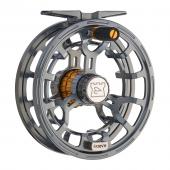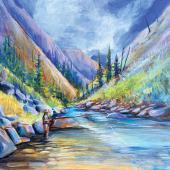Tailwaters Near and Far
As a year-round angler, there are always a few things I look forward to—and saying goodbye to snapping the ice out of my guides with frozen fingers is definitely one of them. In early spring there a lot of great rivers to choose from, but the Bighorn and Missouri are by far the best options for southwest Montana anglers. True, you’ll have to spend a little more time behind the wheel; but those two or three hours on the road are soon forgotten when you’re looking back at an epic day on the water. If driving that far is simply not an option, however, the lower Madison is just 15 minutes from Four Corners. The dry-fly fishing may not be as good as the Missouri or the ‘Horn, but your chances of catching a fat fish on a crayfish or streamer pattern are still fair. Here's a rundown on all three of these great rivers for the spring fishing season.
Bighorn
The best section with the highest fish count is from the Afterbay (Yellowtail Dam) down to 13-mile access. If you’ve got a boat (see sidebar for rental information), you can float this section three ways:
1. Do a shorter float from Afterbay to mile marker three, getting out more often and wade fishing more thoroughly around the red cliffs.
2. Float from mile marker 3 to 13, hitting up the grey cliffs, duck-blind channel, and drive in.
3. Float the whole thing, pushing through the slower, less productive water and fishing the better holes hard.
I prefer option three, but I’ve also had plenty of excellent days on the Horn on foot. Streamer fisherman will also enjoy floating fishing from Mallards to Two Leggins. There aren’t as many fish in this lower section, but the ones that dwell down there often tip the scale at two-four pounds.
If you’re going to wade-fish the Horn, the two best spots to access the river are at the Afterbay and the Three-Mile. I like walking down to the first couple islands before wetting a line. There will be plenty of 12-to-16-inch browns sipping midges along the way, and occasionally you’ll see a larger snout that requires your full attention. For the most part however, I go straight for the jugular and head down to the second island just above from the red cliffs.
Three-Mile access is a beautiful place to wade because the river braids up into several branches. Not only does this make the river easier to cross, but it also creates a lot of seems, drop offs, pockets, runs, and deep buckets where fish like to feed. You will probably see a few more people at this access, but there is plenty of water for everyone. I like to hike up the left side of the river and make a round trip loop coming back down through the braids. Fewer people walk downstream, which also presents some beautiful riffles and the famous “drive-in” hole, recognized by its Michigan riprap. Although the drive-in is fun to see, I’ve had better fishing in the riffle corner below it.
Missouri
From Holter Dam to the Wolf Creek Bridge, there’s a high count of large and healthy fish. This section is easily waded from either side and presents solid opportunities for larger rainbows and browns sipping tiny midge dries and emergers. Wind can sometimes be an issue; however, the nymph fishing in the spring is seldom considered slow. My personal all-time favorite section is from Wolf Creek Bridge to Craig. Here you’ll find some true shark holes and highly prolific holding water for wide-shouldered browns. You can access the river from either bridge, and the further you are willing to walk, the better the fishing gets.
If you brought the boat along, perhaps the most scenic float is from the Dearborn boat ramp to Pelican Point. You’ll get to float through the heart of the canyon, which not only has spectacular, neck-kinking views, but superb tailouts and slicks.
Lower Madison
Here you’ll find great wade-fishing access, deep grassy runs, and some hog browns. To those passing by, the Lower Madison looks like a slow-flowing, flat river with no structure. Upon a closer inspection however, you’ll see that the river is composed of several different weed lanes, runs, and buckets. Finding these honey holes can take a while, but once you know where they are and how many split shot to add, you’ll have a better chance at catching the big one. A spring hike into Bear Trap Canyon is always on my annual list—not only can you have some incredible fishing with midges and baetis, but you’re hiking before the rattlesnakes and Poison Ivy are around. Typically, Bear Trap fishes better on cloudy days, as the fish can become a little shy on a brighter day. A size 18 black-midge larva has been my best bright day fly.
Travel Tips
Bighorn
If you need a boat, you can rent one for $110-$130 a day, which includes a shuttle. Split that three ways and you’re down to about $40 each. Call Bighorn Fly and Tackle (888-665-1321) or Cottonwood Camp (406-666-2391) for reservations. For tackle, flies, and general info, head to the Bighorn Trout Shop, on the left-hand side of the road in downtown Fort Smith. Also feel free to stop by the Yellowstone Angler in Livingston on your way out of town for a hand-drawn map and a handful of flies “to go.” Weather (and tenacity) permitting, campsites abound on the Bighorn. My favorite spots on the ‘Horn are the Bighorn access (13 mile) and Mallard’s Landing. Cottonwood Camp has some great cabins that are relatively cheap and close to the river, located near the Three Mile access.
Missouri
The best fly shop in the area is the Missouri River Trout Shop in Craig. Here you can pick up some technical tips, dry flies, the usual nymphs, another spool of 6X, and arrange a shuttle. These guys also rent ClackaCraft driftboats for $130 day, including shuttle. Isaac’s restaurant in Craig caters to fisherman and is open for dinner from 4 pm to midnight; call 235-3456 for info. I like camping either at the Wolf Creek Bridge or in Craig. Sites are $7 a night for anglers. The best place to get a room in Craig is the Trout Shop. If you don’t mind staying further downstream, the two places I like in Cascade are the Badger Motel and the A & C Motel.
The Season's Best Flies
Zebra Midge
Bighorn, Missouri, Bear Trap
Although this fly is small, (tied on a size 18 curved nymph hook) it has a relatively large hook gap that seems to get lodged in a rainbow’s pearly whites quite easily. I prefer the copper bead and wire simply because it is slightly different than the more common silver wraps and bead. I drop this about 18 inches off my first fly. Inadvertently, this fly has saved my day more than once when the top fly came loose during various big-fish shakedowns—nothing to brag about, but it still helped me land a few fish that I otherwise would have never seen.
McKnight’s Ocular Baetis Nymph
Bighorn, Missouri, Lower Madison
The first time I used this fly, I used a Sparkle Dunn as my indicator fly and I dropped this baby 18 inches below on 5X. On my first cast, a solid Rainbow crushed it. I’ve been a believer ever since. You probably won’t have to bust this guy out of the box until April or whenever the water temperature hits a steady 42 degrees.
McKnight’s Crayfresh
Bear Trap, Lower Madison
I’ve had more hits with this fly on the lower Maddy than anything else. Usually I dead-drift a deadly combo of the Crayfresh and the Bow River Bugger way out in front of the boat with a stack mend (if needed) about four feet under a Thill indicator. Depending on depth, I’ll put one or two BB-sized split shot one foot above the Bow River Bugger.
René Harrop’s Short Wing Baetis Emerger
Bighorn, Missouri, Lower Madison
My Dad showed me this fly over 15 years ago, and it is still the top dogfish taker in my tailwater box. I fish it as a dropper 18 inches under a Baetis No Hackle or Sparkle Dunn, and as my lead nymph with a Zebra Midge as the dropper. Either way, it seems to get hit first and often!
René Harrop’s Hanging Midge
Bighorn, Missouri, Lower Madison
No midge is easy to see, but out of all of them, this one is the best. The white tuft at the top is CDC, which floats naturally and rides high. The way this fly is tied, the hook “hangs” down below the white tuft and looks like an emerging midge—aka a sitting duck! Usually I like to fish this without a dropper and focus on that one rising fish. If you do use a dropper, use something light like a Miracle Nymph or a different midge larva.
Bighorn Sow Bug
Bighorn, Missouri
If you’ve ever looked in the weed beds along the Bighorn, you’ll know exactly what this fly represents—a tiny pink sow bug. I like to use my nippers and cut down the white hackle near the eye of the hook to give the fly a lower profile. A lot of guides fish this fly, so the less obvious the soft hackle, the better. I’d rather fish dries on the Horn, but if it’s just not happening, this is my ace up the sleeve.
James Anderson, George Anderson’s son, manages the Yellowstone Angler in Livingston, Montana. Feel free to drop him a line at [email protected].










